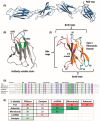Development and Differentiation in Monobodies Based on the Fibronectin Type 3 Domain
- PMID: 32143310
- PMCID: PMC7140400
- DOI: 10.3390/cells9030610
Development and Differentiation in Monobodies Based on the Fibronectin Type 3 Domain
Abstract
As a non-antibody scaffold, monobodies based on the fibronectin type III (FN3) domain overcome antibody size and complexity while maintaining analogous binding loops. However, antibodies and their derivatives remain the gold standard for the design of new therapeutics. In response, clinical-stage therapeutic proteins based on the FN3 domain are beginning to use native fibronectin function as a point of differentiation. The small and simple structure of monomeric monobodies confers increased tissue distribution and reduced half-life, whilst the absence of disulphide bonds improves stability in cytosolic environments. Where multi-specificity is challenging with an antibody format that is prone to mis-pairing between chains, multiple FN3 domains in the fibronectin assembly already interact with a large number of molecules. As such, multiple monobodies engineered for interaction with therapeutic targets are being combined in a similar beads-on-a-string assembly which improves both efficacy and pharmacokinetics. Furthermore, full length fibronectin is able to fold into multiple conformations as part of its natural function and a greater understanding of how mechanical forces allow for the transition between states will lead to advanced applications that truly differentiate the FN3 domain as a therapeutic scaffold.
Keywords: adnectin; biosensor; fibronectin; monobody; non-antibody scaffold; therapeutic.
Conflict of interest statement
The authors declare no conflict of interest. The funders had no role in the design of the study; in the collection, analyses, or interpretation of data; in the writing of the manuscript, or in the decision to publish the results.
Figures





Similar articles
-
Mutational and biophysical robustness in a prestabilized monobody.J Biol Chem. 2021 Jan-Jun;296:100447. doi: 10.1016/j.jbc.2021.100447. Epub 2021 Feb 20. J Biol Chem. 2021. PMID: 33617878 Free PMC article.
-
Teaching an old scaffold new tricks: monobodies constructed using alternative surfaces of the FN3 scaffold.J Mol Biol. 2012 Jan 13;415(2):393-405. doi: 10.1016/j.jmb.2011.12.019. Epub 2011 Dec 16. J Mol Biol. 2012. PMID: 22198408 Free PMC article.
-
Monobodies: antibody mimics based on the scaffold of the fibronectin type III domain.Methods Mol Biol. 2007;352:95-109. doi: 10.1385/1-59745-187-8:95. Methods Mol Biol. 2007. PMID: 17041261
-
Use of Phage Display and Other Molecular Display Methods for the Development of Monobodies.Cold Spring Harb Protoc. 2024 May 2;2024(5):107982. doi: 10.1101/pdb.over107982. Cold Spring Harb Protoc. 2024. PMID: 37137569 Review.
-
Monobodies as enabling tools for structural and mechanistic biology.Curr Opin Struct Biol. 2020 Feb;60:167-174. doi: 10.1016/j.sbi.2020.01.015. Epub 2020 Mar 4. Curr Opin Struct Biol. 2020. PMID: 32145686 Free PMC article. Review.
Cited by
-
Does human homology reduce the potential immunogenicity of non-antibody scaffolds?Front Immunol. 2023 Nov 7;14:1215939. doi: 10.3389/fimmu.2023.1215939. eCollection 2023. Front Immunol. 2023. PMID: 38022550 Free PMC article. Review.
-
FN3 Domain Displaying Double Epitopes: A Cost-Effective Strategy for Producing Substitute Antigens.Front Mol Biosci. 2021 Nov 4;8:742617. doi: 10.3389/fmolb.2021.742617. eCollection 2021. Front Mol Biosci. 2021. PMID: 34820421 Free PMC article.
-
Prospects of Using Protein Engineering for Selective Drug Delivery into a Specific Compartment of Target Cells.Pharmaceutics. 2023 Mar 19;15(3):987. doi: 10.3390/pharmaceutics15030987. Pharmaceutics. 2023. PMID: 36986848 Free PMC article. Review.
-
Engineering Calreticulin-Targeting Monobodies to Detect Immunogenic Cell Death in Cancer Chemotherapy.Cancers (Basel). 2021 Jun 4;13(11):2801. doi: 10.3390/cancers13112801. Cancers (Basel). 2021. PMID: 34199835 Free PMC article.
-
Polymer End Group Control through a Decarboxylative Cobalt-Mediated Radical Polymerization: New Avenues for Synthesizing Peptide, Protein, and Nanomaterial Conjugates.JACS Au. 2021 Nov 30;2(1):169-177. doi: 10.1021/jacsau.1c00453. eCollection 2022 Jan 24. JACS Au. 2021. PMID: 35098233 Free PMC article.
References
Publication types
MeSH terms
Substances
LinkOut - more resources
Full Text Sources
Other Literature Sources
Research Materials

